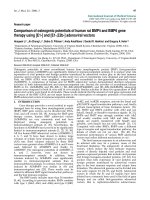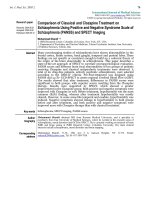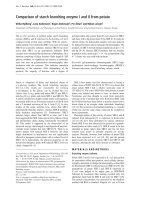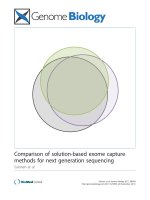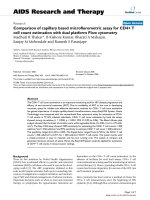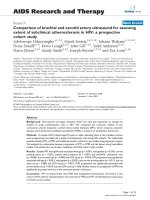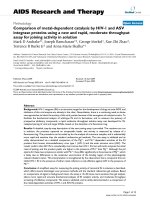Báo cáo y học: "Comparison of Classical and Clozapine Treatment on Schizophrenia Using Positive and Negative Syndrome Scale of Schizophrenia (PANSS) and SPECT Imaging"
Bạn đang xem bản rút gọn của tài liệu. Xem và tải ngay bản đầy đủ của tài liệu tại đây (1.04 MB, 8 trang )
Int. J. Med. Sci. 2005 2
79
International Journal of Medical Sciences
ISSN 1449-1907 www.medsci.org 2005 2(2):79-86
©2005 Ivyspring International Publisher. All rights reserved
Comparison of Classical and Clozapine Treatment on
Schizophrenia Using Positive and Negative Syndrome Scale of
Schizophrenia (PANSS) and SPECT Imaging
Research paper
Received: 2004.06.01
Accepted: 2005.05.01
Published: 2005.05.10
Mohammad Sharafi
1 2
1. fMRI Research Center, Columbia University, New York, NY, USA
2. Department of Psychiatry and Nuclear Medicine, Tehran Psychiatric Institute, Iran University
of Medical Sciences, Tehran, Iran
A
A
b
b
s
s
t
t
r
r
a
a
c
c
t
t
Many neuroimaging studies of schizophrenia have shown abnormalities in the
frontal cortex, limbic system, basal ganglia, temporal and parietal lobes.
These
findings are not specific or consistent enough
to build up a coherent theory of
the origin of the
brain abnormality in schizophrenia
.
This paper describes a
state-of-the-art approach of SPECT to correlate neuropsychological evaluation.
PANSS scores and different brain focal abnormalities of two groups of patients
receiving Clozapine and classical antipsychotic treatments were observed. A
total of 20 drug-free patients, actively psychotic schizophrenic, were selected
according to the DSM-IV criteria. Pre-Post-treatment was designed using
PANSS and
99m
Tc- ECD-SPECT to assess regional Cerebral Blood Flow (rCBF).
The results showed that after treatment, differences in PANSS scores were
significant in both groups, with superior scores resulting from the Clozapine
therapy. Results were supported by SPECT, which showed a greater
improvement in the Clozapine group. Both positive and negative symptoms were
improved with Clozapine as well. Before treatment, hypofrontality was the most
common (85%) finding, whereas after treatment hypofrontality was mostly
cleared. However, in some areas like temporal and caudate, hyperfrontality was
induced. Negative symptoms showed linkage to hypofrontality in both groups
before and after treatment, and both positive and negative symptoms were
improved more with Clozapine therapy than with classical treatment.
K
K
e
e
y
y
w
w
o
o
r
r
d
d
s
s
Schizophrenia, SPECT imaging, PANSS scores
A
A
u
u
t
t
h
h
o
o
r
r
b
b
i
i
o
o
g
g
r
r
a
a
p
p
h
h
y
y
Mohammad Sharafi obtained MD from Kerman Medical University, and a specialty in
psychiatry from Iran University of Medical Sciences, where he worked in the research areas of
schizophrenia, mood disorders and OCD by SPECT. He is currently working on research of brain
fMRI and binge eating at fMRI Research Center, Columbia University. His main clinical
interests include schizophrenia, mood disorders and brain mapping.
C
C
o
o
r
r
r
r
e
e
s
s
p
p
o
o
n
n
d
d
i
i
n
n
g
g
a
a
d
d
d
d
r
r
e
e
s
s
s
s
Mohammad Sharafi, 71-01, 35th Ave # 6, Jackson Heights, NY 11372. Email:
, Tel: 01-917-309-7938
Int. J. Med. Sci. 2005 2
80
1. Introduction
Schizophrenia is a chronic and disabling brain disease affecting around 24 million people worldwide and more than 2 million
Americans in a given year. Approximately 1 percent of the population develops schizophrenia during their lifetime [8-11]. Risk
factors include birth in cities, birth in winter and early spring, and viral infections in the mother during the second and third
trimesters of gestation. A strong association between hypofrontality and negative symptoms of schizophrenia, as well as with
antipsychotic treatment, has been reported. Some studies have reported that about half of the chronic cases of schizophrenia show
hypofrontality at rest [11-13]. Studies have shown that individuals with schizophrenia, including those who have never been treated,
have a reduced volume of gray matter in their brains, especially in the frontal and temporal lobes.[5,7] Patients with the worst brain
tissue loss also have the worst symptoms, including hallucinations, delusions, psychosis and bizarre behaviour [14-17].
Therefore,
through early diagnosis and appropriate treatments we can make the illness less severe and more tolerable for the patients and their
families.
Dopamine hypothesis, which posited that schizophrenia was caused by abnormalities in dopamine production and activity in
the brain, was first proposed in the 1950s. The basis for the hypothesis was that the most widely used drugs for the treatment of
schizophrenia block dopamine D2 receptors and signal transmissions by dopamine. These drugs function as antipsychotic
medications and reduce delusion and hallucination. By contrast, drugs such as amphetamine reinforce signal transmissions by
dopamine and induce schizophrenic symptoms such as delusion and hallucination. A large body of theory and evidence now holds
that a failure to properly develop glutamate neurons is responsible for much of the pathology in schizophrenia. According to this
hypothesis, schizophrenia is associated with increased activity in dopaminergic neurones [19].
Clozapine (Leponex) is the prototype of atypical antipsychotic drugs that are used to treat patients with schizophrenia who are
unresponsive or intolerant to typical antipsychotics. It is effective in treating the positive and negative symptoms of schizophrenia.
As demonstrated in this paper, Clozapine is more effective in schizophrenia than older antipsychotics. It may also help to reduce
relapses, suicide and the need for hospitalization. Clozapine is characterized as atypical by its preferential binding to serotonin 5-
HT2 and dopamine D4 receptors relative to dopamine D2 receptors. Dopamine receptors involved in Clozapine therapy included
D4, D2, serotonin type 2, norepinephrine, acetylcholine, and histamine [20-22].
Functional brain imaging methods have been applied for studying schizophrenia. These methods include positron emission
tomography (PET) [10], SPECT for studying CBF and neuroreceptors, and more recently, functional magnetic resonance imaging
(fMRI) for measuring changes attributable to cerebral blood flow. In this paper, after summarizing the application of brain SPECT in
schizophrenia research, the author presents the study that has been conducted and integrates it with our current understanding of
brain function in schizophrenia.
Scans have become more sensitive through the use of the rotating camera. Improvements in camera designs, collimator design
and in reconstruction algorithms have substantially improved the quality of SPECT images using the Anger type gamma camera.
SPECT images can be merged with MRI and CT, creating a single image that combines anatomy and physiology. Three dimensional
surface and volume- rendered images add perspective and facilitate the localization and sizing of lesions. Systems should be capable
of sequential image acquisition. The option to acquire multiple short studies back to back makes it possible to subsequently discard
segments degraded by patient motion [3, 23, 26,28].
Supporting software includes dynamic filters, multiple angle reconstructions, surface variable attenuation corrections, three
dimensional/conventional /cross sectional displays. The computer then reconstructs 3-D images of the brain (Figure 1). With these
brain maps, physicians are able to identify certain patterns of brain activity in different psychiatric and neurological problems.
Basically, in a typical brain SPECT we are looking for an asymmetry and different activity levels and comparing it to what we know
as a normal brain (Figure 2). A normal SPECT image reveals homogeneous and uniform tracer accumulation throughout the cerebral
cortex, with the cerebellum being the area with the most intense activity [24, 26, 28].
2. Material and Method
The study was conducted under a protocol approved by the committee at Tehran Psychiatric Institute, Iran Medical University
and Rajai Hospital Research Center, Tehran, Iran. Twenty random samples in an acute phase of schizophrenia (drug free and drug
naive) were selected after a proposal study had been completed, according to DSM-IV from the different outpatient and inpatient
clinics and teaching hospitals. Eleven men (ranging from 24-40 years) and 9 women (ranging from 18-40 years) were placed in 2
groups, the Clozapine and classical groups, according to the selected treatment. The mean duration of illness was 8.7 years, ranging
from 1-19 years (Table 1). Two subjects were not cooperative for the second SPECT, so data from these two patients were not
included. 88% of the classical and 90% of the Clozapine group suffered from delusion, while 88% of the classical and 54% of the
Clozapine group showed hallucination. The control subjects were 12 healthy volunteers [8 men aged 34 ± 6.5 (S.D.) years, 4 women
aged 33 ± 3.5 (S.D.) years]. Drug-washout was 3 months prior to the PANSS and SPECT scanning. Exclusive criteria: age less than
18 years, more than 65 years, neurological and general medical condition and pregnancy. The mean daily dosage for Clozapine:
300mg, and for classic: equal to 600 mg chlorpromazine.
SPECT Acquisition
The SPECT study was performed using a single-head rotating gamma camera (Sophycamera- SMV-DSX). 64-40 seconds
frames were collected during a 360 degree rotation in a 64x64 matrix with a zoom of two obtaining a 4.5 mm pixel size. Data
acquisition was started 40 minutes after IV injection of 740 MBQ (20 mci) of
99m
Tc-ECD (Neurolite, Kavoshyar co.). As a clinical
tool for rCBF evaluation by SPECT, ECD (ethyl cysteinate dimmer) has recently being introduced. Results of rCBF in schizophrenia
are considerably limited to the use of the older radiopharmaceuticals like
99m
Tc-HMPAO (Hexamethyl propylene amine oxide) and
I
131
-IMP (Iodoamphetamine). Fewer data are available from rCBF studies in schizophrenia by
99m
Tc-ECD
[23]
. In general, ECD has
several favourable characteristics: A. Chemical stability lasting several hours after reconstitution, B: Fast blood clearance, C: High
signal-to-noise ratio.
The pre and post treatment SPECT results were differentiated from severe hypo (-3) to severe hyper (+3) perfusion (zero
means normal scan). Pre and Post-treatment was designed using the PANSS and
99m
Tc- ECD-SPECT to assess regional Cerebral
Int. J. Med. Sci. 2005 2
81
Blood Flow. Patients were assessed psychometrically both times the day before the scans with PANSS, a 33-item scale with 1 to 7
points (normal to extremely abnormal) for each item and sub-scores for 7 positive, 7 negative, and 16 global psychopathological
symptoms: delusions, formal thought disorders, hallucinations, agitation, grandiosity, suspiciousness/persecution, and hostility (P1
to P7); blunted effect, emotional withdrawal, poor rapport, social passivity and apathy, difficulty in abstract thinking, lack of
spontaneity and flow of conversation, and stereotyped thinking (N1 to N7); and health concerns, anxiety, guilt, tension, mannerisms
and posturing, depression, motor retardation, uncooperative behavior, unusual thought contents, disorientation, poor attention, lack
of judgment and insight, avolition, poor impulse control, self-centeredness, and active social avoidance (G1 to G16)
.
[18]
A brain CAT scan or MRI was performed on each subject before the SPECT, to rule out any pre-existing medical conditions
and for parallel comparison with SPECT. As stated in Table 3, ROIs (region of interest) were positioned in 8 canthomeatal slices in
each side. For every ECD brain SPECT the subjects were seated in a quiet room with closed eyes, 15 minutes before the injection.
Before the SPECT scanning, all subjects had an intravenous line
established while they were lying down. Each subject received
an
intravenous injection of
99m
Tc-ECD, which crosses the blood–brain
barrier on first pass, is rapidly taken up by neural cells,
and is
distributed in proportion to regional cerebral perfusion.
Because
99m
Tc-ECD remains fixed in the cells after uptake, its distribution
provides a picture of the pattern of brain perfusion immediately
after administration. Therefore, the effect of sedation on measured
rCBF should be negligible. Thirty minutes after the administration
of
99m
Tc-ECD, each subject was given sedation in the amount of
10 mg Diazepam
to decrease motion during scanning. Ten minutes after injection
of Diazepam, SPECT scans were taken. Therefore,
data acquisition started 40 minutes after ECD IV injection for each subject.
3. Results
Table 1 shows demographic and clinical characteristics of the study. SPECT scans were interpreted independently by three
nuclear physicians who were unaware of the patients’ diagnoses. Intra-observer agreement ranged from 60 to 90%. PANSS scores
also were evaluated by three researchers independently, and the agreement ranged from 75 to 95%. Before treatment there was no
significant difference on the PANSS between the Clozapine and classical groups. We conducted Levene’s test for equality of
variances in PANSS; F = 0.197, P = 0.662 and t-test for independent samples (before any treatment); t (pre)= 2.50, t (post)= 2.48,
was done to rule out possibility of bias in choosing the samples. In addition, statistical analysis ruled out the possibility of any
baseline difference effects between the Clozapine and classical treatments.
The PANSS scores, pre and post treatment (Table 2), were compared using t-tests for dependent samples (for ten subgroups).
The Pearson’s correlation coefficient was used between different SPECT areas and PANSS subgroups. All statistical tests were two-
tailed with a 0.05 alpha level. Before treatment, the total classical PANSS score was 175 and after treatment it decreased to 111
(P<0.001, N=9); t = -5.98. Before treatment, the total PANSS score in the Clozapine group was 235, and after treatment it decreased
to 123 (P<0.0001, N=11); t = -7.83. Results were supported by SPECT, which showed a greater improvement in the Clozapine
group.
Table 3 shows the comparison of the mean values of relative perfusion in schizophrenic subjects pre and post treatment. The
results show that the mean rCBF values of the schizophrenic patients were significantly lower than those of the control in all frontal,
temporal, thalamus/basal ganglia, caudate and parietal regions. So, we selected the region of interest for correlation.
Table 4 shows the severity index of pre-post treatment in both groups. The results show the superiority of clozapine to classical
treatment in schizophrenia, particularly in Superior frontal, anterior and posterior parietal and caudate, which show the most changes
in the Clozapine group.
In Table 5, the findings show only significant correlations (r > .50, r <
-.50), p< 0.05. The most common abnormality in the
schizophrenic brain SPECT was shown to be a decreased rCBF in the superior frontal region, which was cleared mostly by the
Clozapine therapy.
Table 1: Demographic and clinical characteristics of the study
Clozapine (11)
Mean ± SD
Classic (9)
Mean ± SD
Gender 63% M 36% F 55% M 44% F
Job 36% E 63% U 44% E 55% U
Age 29.18 Y ± 6.30 30.9 ± 8.72
No. of hospitalizations 3.7 T± 2.5 2.1 ± 2.0
Duration of disease 9.7 Y ± 3.1 8.6 ± 3.7
Duration of treatment 6.6 mon ± 4.0 7.7 ± 4.6
Suicide 9% 22%
OCD 27% 22%
Family history 45% 55%
ECT history 18% 22%
Smoking 27% 55%
Marriage 0% 44%
M: male, F: female, E: employed, U: unemployed, Y: year, T: times, Mon: month.
Int. J. Med. Sci. 2005 2
82
Table 2: Mean PANSS scores pre-post treatment in different groups
PANSS scores Clozapine (11) Classic (9)
PreTx±SD PostTx±SD t p Pre Tx ± SD PostTx ± SD t p
Positive 34±8.81 17±3.76 -7.71 .0001 24.4 ±7.8 14.11 ±3.78 -4.83 .001
Negative 34.45± 8.8 18.45±5.62 -7.34 .0001 24.2 ±7.9 16 ± 4.5 -5.07 .001
Composite (P-N) -0.36±6.96 -.4 ±2.36 -1.58 .145 0.22± 7.82 -1.77±4.63 -1.10 .303
General Psychopath. 64.27±16.17 32.16±11.1 -6.96 .0001 50.6± 16.5 33.3±11.16 -5.47 .001
Anergia 31.87±5.64 9.27±2.72 --- --- 12.11 ±5.46 7.77±2.81 --- ---
Thought disturbance 18.72±3.46 9.63±2.57 --- --- 12.7 ± 5.2 9± 2.54 --- ---
Activation 11.9±3.35 6±1.34 --- --- 8.55 ±3.12 5.33± 2 --- ---
Paranoid bellig. 14.18±3.54 7.27±1.27 --- --- 9.33 ±3.55 5.55± 1.5 --- ---
Depression 14.63±3.26 8.18±1.83 -6.27 .0001 13.11± 4.01 8.55±3.24 -4.90 .001
Supplemental
25.45±6.28 12.18±1.99 --- --- 19.4 ±5.87 12±4.12 --- ---
Table 3: Comparison of means in different brain regions
Right
Pre Tx
± SD
t p Right
Post Tx
± SD
t p Left
Pre Tx
± SD
t p Left
Post Tx
± SD
t p
Sup. frontal -1.07±.93 -5.874 .000 -.50±.659 -3.71 .001 -.73±1.00 -3.71 .001 -.33±.56 -2.89 .008
Inf. frontal -.538±.98 -2.776 .010 -.25±.442 -2.76 .011 -.65±.845 -3.94 .001 -.166±.38 -2.14 .043
temporal .576±1.20 2.44 .022 .166±.48 1.696 .103 .38±.752 2.6 .015 .20±.588 1.73 .096
Post. parietal -1.3±1.12 -5.93 .00 -.70±.80 -4.3 .00 -1.1±1.10 -5.13 .000 -.666±.81 -4.0 .001
Ant. parietal -.69±.97 -3.638 .001 -.458±.83 -2.69 .013
-.69±1.04 -3.36 .002
-.20±.50 -2.00 .057
caudate -3.85E-
02±.527
-.372 .713
-4.17E-
02±.204
-1.00 .328 3.846E-
02±1.038
.189 .85 .000±.41 .000 1.00
Thalamus/Basal
Ganglia
-.15±.73 -1.07 .29 -.20±.50 -2.0 .057 -.19±.80 -1.22 .232 .000 .000 1.000
The Cerebellum had no significant changes before and after treatments. The occipital region only showed some non-significant changes.
Table 4: Severity index was calculated as; degree of severity x number of hypo/hyper-intense areas in different brain regions.
Brain regions
Clozapine (11)
Classic (9)
Pre-Tx Post-Tx Pre-Tx Post-Tx
Superior Frontal* -5.16; 0 -2.5; 0.5 -2.75;0 -2.5; 0
Inferior Frontal -4.5; 0.66 -2.0; 0 -1.5; 0 -2.0; 0
Temporal -1.1; 4.03 -1.0; 4.33 -0.5; 4.33 0; 1.0
Posterior parietal -5.75; 0 -4.0; 0 -4.5; 0 -2.75; 0
Anterior parietal* -6.66; 0 -3.0; 0 -3.33; 0 -3.25; 0
Caudate* -0.42; 2.71 -0.1; 0.5 -0.5; 0.5 -2.0; 0.5
Thalamus/basal ganglia -1.33; 1.2 0; 1.0 -1.0; 1.0 -1.0; 1.0
Negative numbers mean decrease of rCBF and positive numbers mean increase in rCBF. * Means of severity show the most changes in these
regions, particularly in the Clozapine group.
Table 5: Correlation between psychological symptoms and region of interest before and after treatment; only coefficients with r >.50
/ r <-.50 are shown (n= 20), p< 0.05
Brain
Regions\ PANSS
Positive Negative Composite
(P-N)
General
Psychopath.
Anergia
Thought
disturbance
Paranoid
bellig
Depression
Pre Post Pre Post Pre Post Pre Post Pre Post Pre Post Pre Post Pre Post
Sup. frontal *LT
-.75
LT
-.51
RT
.59
LT
-.53
*LT
-.71
*LT
-.68
RT
-.55
temporal RT
-.56
LT
.50
Post. parietal RT
-.51
RT
-.50
LT
-.53
Ant. parietal LT
-.52
caudate RT
.51
Thalamus/Basal
Ganglia
LT
.55
LT
.55
Inferior frontal and cerebellum have no significant correlation with PANSS scores.
Int. J. Med. Sci. 2005 2
83
*Only bold numbers (first row) in superior frontal had r < -0.60, p< 0.01.
At this step all PANSS subgroups were related to the brain regions, and this showed the correlation between positive
symptoms with the left thalamus/basal ganglia, left anterior parietal and left superior frontal after treatment in both groups. For
negative symptoms correlations were seen in the left temporal, right post parietal, right thalamus/ basal ganglia before treatment and
with the left superior frontal after treatment in both groups, but as the findings show, the correlation was only significant with two of
them (Table 5). The composite (positive-negative) subgroup correlation was significant with the right caudate before and with the
right superior frontal after both treatments. General psychopathology correlation was only significant with one region in post
treatment: the left superior frontal. And for Anergia it was significant in bilateral post parietal regions in both groups. Paranoia
correlated significantly with two brain regions: the left temporal before and the left superior frontal after both treatments. For
depression the correlation was significant only with one region: the right superior frontal in post-treatment in both groups.
Incidentally there was a strong correlation (p < 0.01) between the right temporal and right anterior parietal, and also between
the right caudate and right thalamus/basal ganglia. In addition, based on our study, positive symptoms have a strong correlation with
paranoia, thought disturbance and less with negative symptoms; whereas, negative symptoms have a strong correlation with
activation (P< .007) and less with paranoia (P< .011).
4. Discussion
First, PANSS score differences (pre-post treatment) were significant in both the classical and Clozapine groups and for all
subgroups, except for the composite subgroup, which was positive-negative. Therefore, both treatments have their benefits for
schizophrenia. Some studies have reported that the efficacy of Clozapine is clinically significant on the negative symptomatology
but is delayed compared to the efficacy on the other dimensions of symptomatology evaluated using the PANSS [3,20,22,25,26].
Based on these studies, both positive and negative symptoms seem to be improved with Clozapine. In addition, some studies have
shown that negative symptoms improve in direct relation to positive symptoms in schizophrenia after Clozapine therapy [25,26].
Based on our study, positive symptoms have the strongest correlation with paranoia and thought disturbance and then with negative
symptoms, whereas negative symptoms have a strong correlation with activation and less with paranoia. In other words, positive
symptom improvement means less paranoia and more cooperativeness. And negative symptom improvement shows more activity
and cooperativeness, and less paranoia as well.
In our study, difference means of PANSS subgroups were more significant in the Clozapine group than the Classical group,
which showed in decreasing order: general psychopathology, anergia, positive and negative symptoms, in compare with the classic
group, which was in decreasing order; general psychopathology, positive and negative symptoms. This finding shows the priority of
positive symptom improvement to negative symptom by both treatments.
Second, corresponding with the widespread literature that frontal hypo-perfusion is the most consistent finding in the resting
state of chronic schizophrenia [10-13,27], the most common finding in our study was a decrease of perfusion, mostly (85%) in the
superior frontal region (17 out of 20 cases). Although some researchers have pointed out that frontal hypo-perfusion might be
associated by chronicity of illness or long-term anti-psychotic treatment or even the aging process, most studies have shown a
reduced frontal cerebral blood flow in drug-naïve patients. Thus, decrease of frontal perfusion can be an existing finding before any
clinical manifestation of schizophrenia.
Third, in our study, we found a significant negative correlation between negative symptoms and hypofrontality in both groups,
especially in the left superior frontal (Table 5). This relationship between negative symptoms and frontal hypo-perfusion has been
supported by many other studies [12,13].
However, there is another argument that in the first-episode of schizophrenia, and in the
acute phase, hyper perfusion in the frontal and temporal region is dominant, unlike the chronic phase which exhibits hypo-perfusion.
At any rate, such hypo-perfusion correlates positively with some acute schizophrenic symptoms and with their severity [6,12].
Fourth, in the temporal region there was an increased perfusion and mostly in the left side with the Clozapine therapy, but not
with the classical treatment. This pattern is usually seen in hallucinatory states [1,11,14,15], but here under antipsychotic treatments
and the resulting PANSS scores improvement, this finding may demonstrate an over-reaction to Clozapine therapy, not a
hallucinatory state. Future studies will help us understand more about this reaction.
Fifth, contrary to our expectation, based on passed studies, a significant increased rCBF was observed in the thalamus,
particularly with Clozapine treatment. This can be due to Clozapine’s effect on the thalamus by dopaminergic receptors, which is
less with the classical treatment. It may explain some higher efficacy of Clozapine to the classical treatment, especially on refractory
schizophrenia.
In conclusion, based on our study and past studies, schizophrenia can affect different brain regions, from the frontal, temporal,
parietal to the thalamus and basal ganglia. Some studies show hypo-perfusion, others hyper-perfusion. This variety and
inconsistency in results may explain the real nature of this illness. Our study has shown the superiority of Clozapine to old
antipsychotics in treating schizophrenia.
Acknowledgments
I wish to thank Kamali M, Dr. Seyfollahi-asl Sh, Dr. Hirsch J, Dr. Geliebter A, Lorence M, Dr. Sharafi R, Afkhami A, Dr.
Mostafavi-abdolmaleky H, Dr. Nasr-esfehani M, Dr. Rastgoo F, Sharafi E, Dr. Yaghoobi N, Dr. Hekmat and Mr. Kahani for their
useful comments and suggestions. This article would not have been possible without the assistance of my dear friend, Dr. Seyfollahi
who was instrumental in taking the SPECT pictures. This study was done in cooperation with Navvab Psychiatric Hospital and Rajai
Hospital, Nuclear Medicine Department, Tehran, Iran.
Conflict of interest
The author has declared that no conflict of interest exists.
